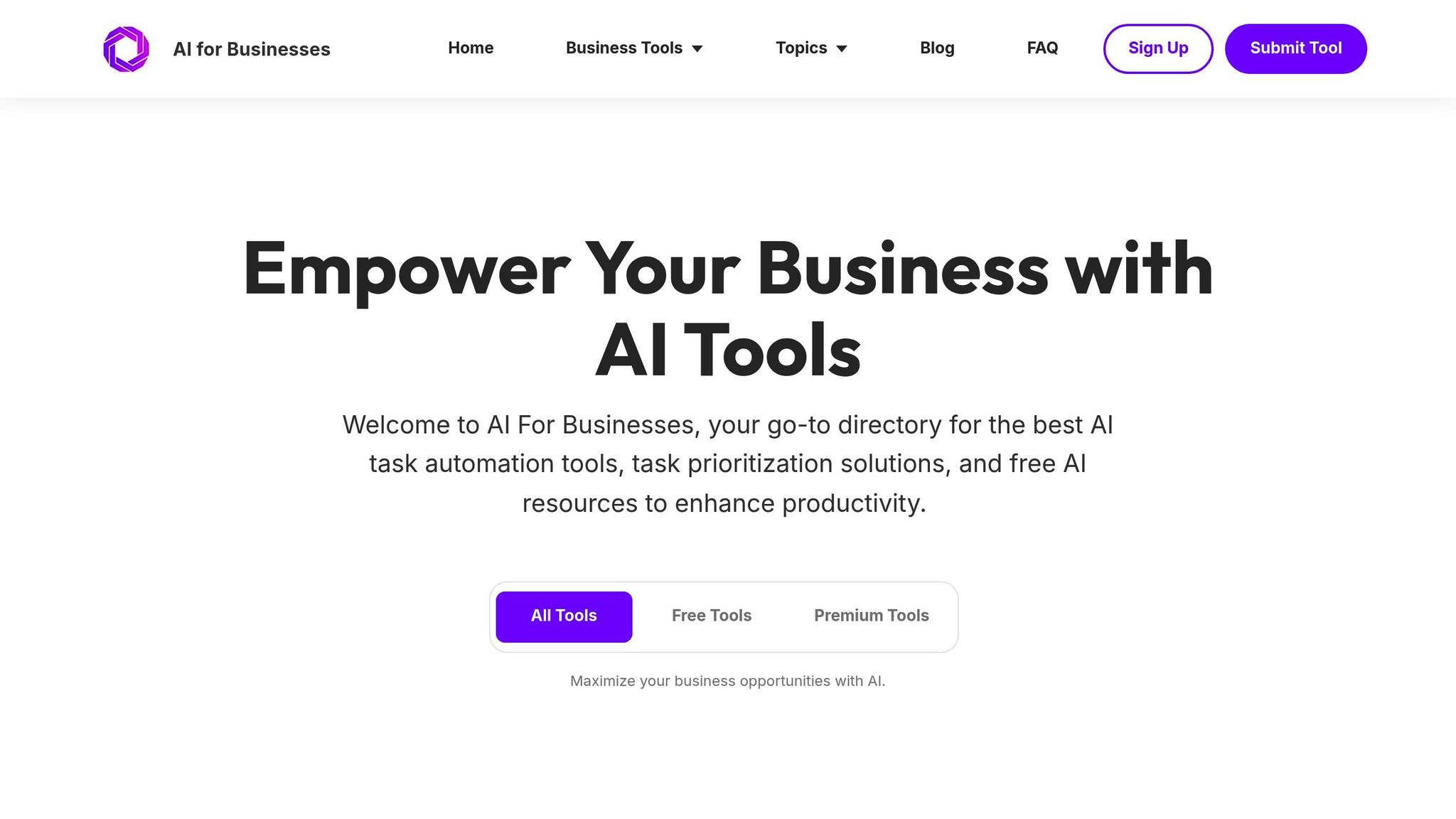AI is transforming how businesses manage cybersecurity threats by automating the process of identifying and prioritizing vulnerabilities. Here's what you need to know:
- What it does: AI analyzes threats based on severity, exploitability, and business context, helping companies focus on the most critical risks.
- Why it matters: Traditional methods are slow and prone to errors, leaving systems exposed. AI reduces false alerts, speeds up responses, and ensures resources are used effectively.
- Who benefits: Small and medium-sized businesses (SMEs) gain the most, as AI helps them manage security even with limited budgets and staff.
AI tools like dynamic risk scoring systems and machine learning models make vulnerability management faster, more accurate, and less resource-intensive. However, challenges like understanding AI outputs, integration issues, and costs still need attention. Combining AI with human expertise ensures better decisions and stronger security.
AI Fuel for Vulnerability Management Teams: Prioritize & Remediate Security Risks Faster
Main Benefits of AI-Powered Vulnerability Prioritization
AI takes vulnerability prioritization to the next level by automating complex analyses, cutting down on false alerts, speeding up response times, and making the most of available resources. In a world where cybersecurity threats are constantly evolving, these advantages are essential for ensuring swift and accurate responses. The result? Better precision, faster reactions, and smarter resource management.
Improved Accuracy with Fewer False Alerts
Traditional vulnerability scanners often overwhelm security teams with a flood of alerts - many of which turn out to be irrelevant. AI steps in to filter out the noise, homing in on the vulnerabilities that matter most. This allows security teams to focus their efforts where it truly counts, minimizing wasted time and enhancing overall efficiency.
Faster Response Times
Speed is everything when it comes to cybersecurity. AI automates parts of the vulnerability analysis process, enabling organizations to quickly identify and address critical issues. When new vulnerabilities surface, rapid assessment is key to limiting the window of opportunity for attackers. This makes AI a powerful ally in strengthening cybersecurity defenses.
Smarter Resource Allocation for Small Businesses
For small businesses with limited cybersecurity budgets and staff, AI can be a game-changer. Beyond just saving time, AI helps these organizations allocate their resources more effectively. By pinpointing the most urgent vulnerabilities, even small teams can tackle critical threats without spreading themselves too thin.
For companies in the U.S. looking to enhance their security measures, platforms like AI for Businesses provide tailored AI tools that not only streamline cybersecurity but also improve other areas of business operations. These solutions are especially helpful for smaller organizations aiming to stay secure while maximizing efficiency.
AI Tools and Systems for Vulnerability Prioritization
AI-powered vulnerability management systems are reshaping how organizations handle security threats. By moving beyond traditional signature-based methods, these tools use advanced algorithms to analyze threats dynamically, offering a more responsive approach to cybersecurity.
Dynamic Risk Scoring with AI Models
AI models calculate dynamic risk scores by pulling together a variety of data points to assess threats more accurately. Unlike static databases that assign fixed severity levels, these systems consider factors like network structure, the importance of specific assets, exploit availability, and up-to-date threat intelligence.
For example, vulnerabilities on high-priority servers are flagged as urgent, while those on isolated systems with minimal network access are ranked lower. The models also adapt to changes over time. If hackers begin targeting a specific software version, the system immediately adjusts its vulnerability scores to reflect the heightened risk. This ability to adapt in real time ensures that organizations can respond to the most pressing threats first.
These dynamic scoring methods lay the groundwork for specialized tools that streamline the entire vulnerability management process.
Tools Available on AI for Businesses

The AI for Businesses directory highlights several tools that can enhance security and vulnerability management, especially for small and medium-sized enterprises. While not all are focused solely on security, they provide valuable support for building a well-rounded security program.
- Stability.ai: Known for its AI-driven image and content generation, this tool is handy for creating clear, visually engaging security documentation and training materials. These resources ensure that both technical and non-technical teams fully understand remediation steps.
- Writesonic: This AI writing assistant simplifies the creation of security policies, incident response plans, and vulnerability assessment reports. Well-crafted documentation helps teams follow remediation procedures accurately and meet compliance standards.
These tools address documentation and communication gaps, which are often overlooked but critical aspects of effective vulnerability management.
Common Implementation Challenges
While AI-driven systems offer many benefits, they also come with challenges that organizations must navigate.
One major hurdle is understanding AI outputs. Security teams need to interpret machine learning recommendations and understand the logic behind risk scores. Without this understanding, the insights provided by AI may go underutilized or misapplied.
Another challenge is the shortage of skilled professionals in both cybersecurity and AI. Successfully implementing these tools requires staff who can bridge the gap between security expertise and AI technology. Without this expertise, teams may either ignore valuable recommendations or follow them without proper validation.
Balancing automation with human judgment is also critical. While AI excels at analyzing large datasets and spotting patterns, human oversight is necessary to provide business context and make informed final decisions.
Integration can be unexpectedly complex. AI tools must work seamlessly with existing security systems, asset management platforms, and IT service management tools. Poor integration can lead to data silos, reducing the effectiveness of AI insights.
Cost is another factor to consider. While AI systems can lower operational expenses in the long run, the initial investment in software, training, and possibly new hardware can be substantial. Small businesses, in particular, need to weigh these costs against the potential benefits.
Finally, data quality is a common stumbling block. AI models rely on accurate and complete information about network assets, software versions, and configurations. If an organization’s asset management practices are lacking, the AI system’s output will likely be unreliable until these foundational issues are addressed.
sbb-itb-bec6a7e
Problems and Limits of AI Vulnerability Management
AI has brought significant advancements to vulnerability management, but it’s not without its shortcomings. To implement AI effectively, organizations need to understand its limitations and address potential risks that could compromise their security efforts.
Current Issues with AI Security Tools
AI-based security tools face several challenges that can hinder their effectiveness. One major issue is the lack of transparency in how these tools make decisions. This "black box" nature makes it difficult for security teams to explain or justify AI-driven remediation actions to management.
Another challenge is accuracy. False positives remain a problem, with even advanced AI systems sometimes flagging low-risk vulnerabilities as critical. This wastes valuable resources. On the flip side, false negatives - where serious vulnerabilities are overlooked or misclassified - can leave organizations exposed to significant threats.
Data bias is another concern. AI models trained on historical data may inherit biases or fail to identify new and emerging threats, which can lead to flawed risk assessments, especially in diverse or evolving technology environments.
To address these issues, organizations must demand greater transparency from AI vendors and implement strong oversight mechanisms. For example, Stability AI offers an Annual Integrity Transparency Report, which provides a detailed look into how their AI systems function, including potential inaccuracies or biases.
Ultimately, the best approach combines automated analysis with human expertise to ensure a more balanced and effective vulnerability management system.
Combining AI with Human Expertise
Human expertise plays a critical role in validating and contextualizing AI outputs, particularly in areas where the data or operational context is incomplete. Security professionals bring a nuanced understanding of organizational priorities, regulatory requirements, and operational constraints - elements that AI often overlooks.
The most effective systems establish validation workflows where AI-generated recommendations are reviewed by humans, especially in high-stakes or low-confidence scenarios. Custom workflows tailored to specific organizational needs can also help refine AI systems to better align with unique operational environments. Stability AI highlights this approach, stating, "The control you've been looking for. Precision for your vision. We partner with you to build custom workflows that meet your production standards". These tailored solutions can reduce biases and improve the accuracy of vulnerability assessments.
Maintaining expertise in both cybersecurity and AI is essential. Teams with this dual knowledge are better equipped to interpret AI outputs, identify potential errors, and fine-tune system parameters. Additionally, self-hosting AI systems can give organizations greater control over data and model adjustments, helping to address inherent biases in vulnerability management.
Areas for Future Development
To address current limitations, AI systems need to improve in several key areas, including transparency, integration, and adaptability.
One major focus is on making AI decision-making more interpretable. Researchers and vendors are working to develop tools that allow security teams to understand not just what recommendations are being made, but why. This kind of transparency is crucial for building trust in AI systems.
Scalability is another area for improvement. AI needs to handle increasingly complex network environments while integrating seamlessly with existing security tools, IT platforms, and business applications. Breaking down data silos will enable more comprehensive risk assessments.
Real-time adaptability is also critical. AI systems must be able to quickly incorporate new threat intelligence to stay ahead of emerging risks.
Organizations looking to adopt AI should prioritize solutions that come with strong expert support and meet compliance standards. Stability AI emphasizes this approach, stating, "Ready for business. Proven. Trusted. Ready. Everything you need for enterprise deployment: indemnification, expert support, compliance, and safe scalable integration". This ensures the AI system is not only effective but also aligned with ethical and regulatory requirements.
Advancements in bias reduction techniques are also on the horizon, promising more accurate and equitable risk assessments across diverse environments. These developments will be key to ensuring AI remains a reliable tool in the fight against vulnerabilities.
Summary and Main Points
AI is revolutionizing vulnerability management by shifting it from slow, manual processes to proactive, intelligent systems. This shift is especially impactful for small and medium-sized businesses (SMEs) that need robust security solutions despite limited resources.
How AI Changes Security Management
AI transforms security management by automating time-intensive tasks and improving accuracy. It tackles three key challenges: speed, precision, and efficient use of resources.
One of AI's standout features is its ability to provide contextual intelligence. Instead of treating every critical vulnerability the same, AI evaluates factors like the importance of an asset, its exposure within the network, and the current threat landscape. This allows businesses to prioritize risks strategically, focusing on protecting their most valuable assets first while ensuring overall security remains strong.
This shift to AI-driven processes does more than just save time - it fundamentally changes how organizations approach security. By enabling a proactive stance, businesses can anticipate and prepare for threats instead of merely reacting to incidents. This proactive approach is becoming essential as cyber threats grow more sophisticated and frequent.
Next Steps for Small and Medium Businesses
To take advantage of these benefits, SMEs need a clear strategy for integrating AI into their security systems. Many SMEs face challenges like limited security staff and overwhelming volumes of alerts, making AI-powered solutions an ideal fit.
The first step is to assess current vulnerability management practices and identify key gaps. From there, SMEs can explore AI tools tailored to their needs. For instance, platforms like AI for Businesses offer curated tools designed to enhance operations, including cybersecurity and risk management.
When selecting solutions, SMEs should prioritize tools with strong expert support and compliance features. Starting with small pilot projects can help businesses test AI's capabilities in a controlled environment, reducing risks while building confidence and internal expertise.
Budget is always a concern for smaller organizations, but many AI tools now come with flexible pricing models that scale as businesses grow. SMEs should focus on tools that deliver immediate improvements in critical areas rather than attempting to overhaul their entire system at once.
Finally, building AI literacy within the organization is crucial. This ensures that employees can effectively combine automated insights with human oversight, maximizing the value of AI investments while maintaining control over security decisions.
In today’s competitive landscape, the ability to respond swiftly to security threats while staying efficient is a significant advantage. By adopting AI-driven vulnerability management, SMEs can not only protect their digital assets but also compete more effectively with larger organizations in an ever-evolving threat environment.
FAQs
How does AI make vulnerability prioritization more accurate and efficient?
AI improves vulnerability prioritization by processing large volumes of data at incredible speed, pinpointing the most pressing risks with a level of accuracy that surpasses traditional approaches. Through machine learning algorithms, it evaluates factors such as exploitability, potential impact, and threat intelligence from real-world scenarios. This allows businesses to zero in on the vulnerabilities that genuinely require attention.
By automating these tasks, AI minimizes human error and saves valuable time. This means organizations can tackle security gaps more efficiently and make smarter decisions about how to allocate their resources.
What obstacles might small businesses face when adopting AI tools for cybersecurity, and how can they address them?
Small businesses often encounter obstacles like a lack of technical know-how, high upfront costs for AI tools, and the challenge of training staff to use these technologies effectively. These barriers can make adopting AI for cybersecurity feel like an uphill battle.
One way to tackle these challenges is by choosing user-friendly AI tools that don’t require advanced technical skills. Many platforms now offer tailored AI solutions designed specifically for small businesses, making it easier to strengthen cybersecurity without straining resources. Focusing on tools that directly address the unique needs of your business can simplify the integration process and help you get the most out of your investment.
Why is it essential to combine AI and human expertise in managing vulnerabilities, and how can organizations strike the right balance?
Combining AI capabilities with human expertise in vulnerability management creates a powerful approach to identifying and addressing risks. AI excels at processing massive amounts of data and spotting potential threats quickly. Meanwhile, human professionals contribute essential context, critical thinking, and strategic judgment that AI alone cannot replicate. Together, they form a system that’s both efficient and precise when it comes to prioritizing vulnerabilities.
To strike this balance, organizations should clearly define the roles of each. AI can handle tasks like data analysis and automation, freeing up human teams to focus on complex decisions that require nuanced understanding. Regular training is also key - this ensures teams can effectively interpret AI-generated insights and apply them to real-world scenarios. Additionally, creating feedback loops allows human input to continuously refine and improve AI systems, making them smarter and more reliable over time.


